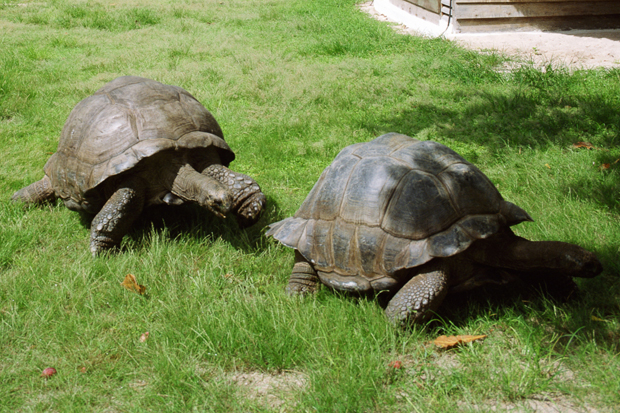It’s April. It’s spring. The daffodils and the cowslips are in flower. The birds are chirping merrily. But where are the tortoises? There were two of them, a big one called Alice and a small one called Gertrude. They have been in my care since last summer when a friend, their owner, moved from her London house, which had a garden, into a flat nearby, which hadn’t. So the tortoises came up here to my house in Northamptonshire to be looked after by me.
I put them in a patch of garden, about 20 yards by 15, surrounded by walls and yew hedges. Within these was erected a chicken-wire fence, buried into the ground so that they couldn’t escape; and there they stayed happily from June until the autumn when the weather got cold and they disappeared, presumably to hibernate.
Tortoises can live a very long time. According to Wikipedia, the oldest tortoise ever recorded was Tu’i Malila, which was allegedly presented in 1777 by Captain Cook to the Tongan royal family, with whom it remained until it died in 1965 aged 188. Nobody knows exactly how old Alice and Gertrude were when they came here, but it’s thought that Gertrude might have been around 20 and Alice around 50. In any event, they had lived happily for years in their London garden, disappearing to hibernate in the autumn and reappearing again in the spring.
The question is why they have not yet surfaced now. There are no holes in the fence to suggest they could have got out. There are also no holes in the ground to indicate where they might have gone to hide for the winter. But then I know very little about the habits of tortoises and just assumed that they would somehow take care of themselves. Only too late have I now looked up some websites on tortoise care and found that keeping tortoises is no simple matter. On the other hand, all guides to looking after any kind of pet make the task seem infernally difficult. If one read them in advance, one would be deterred from even keeping a chicken.
The first thing you learn about the hibernation of tortoises is that the experts use the word ‘hibernate’ as a transitive verb; it’s something you do to them, rather than something they do for themselves. You should put them in a heated ‘vivarium’ — a box with a glass front through which you can inspect them — which should be kept at a steady temperature of between 6 and 7° Celsius so that they can’t freeze and die of cold. But you should only do this after a period of enforced fasting and after weighing and measuring them and closely inspecting every bit of them — ears, eyes, noses, mouths, tails, shells, legs, and so on. The hibernation period should be neither too long nor too short; and when it wakes up in the spring, ‘Don’t forget to bath your tortoise every day to rehydrate it.’
Well, of course I didn’t know that I should do any of these things and left the poor creatures to their own devices. But so, apparently, did their owner in London, without any obvious ill effects. Hibernation underground, says the Tortoise Trust, can work, but ‘works best in sandy, well-drained soils’. ‘Dense clay soils [like mine, of course] are not well suited,’ it says. ‘Major drawbacks are that it is impossible to inspect the tortoise regularly, it may be vulnerable to rodent attack, and if the soil is too wet or damp it could die.’
These are grim warnings, but ones that I have heard far too late. I hate the idea that the tortoises could have been killed by rodents, even if they would at least have been asleep at the time. But I am hoping that they may still lumber out of the ground at some point. The experts say that tortoises may hibernate for four or even five months, and it was only in late November last year that they vanished from sight. That was only four months ago, so perhaps there are still grounds for hope. Also, the weather — which until last weekend was so unpleasant — may have inclined them to sleep a little longer yet.
Got something to add? Join the discussion and comment below.
Get 10 issues for just $10
Subscribe to The Spectator Australia today for the next 10 magazine issues, plus full online access, for just $10.
You might disagree with half of it, but you’ll enjoy reading all of it. Try your first month for free, then just $2 a week for the remainder of your first year.













Comments
Don't miss out
Join the conversation with other Spectator Australia readers. Subscribe to leave a comment.
SUBSCRIBEAlready a subscriber? Log in